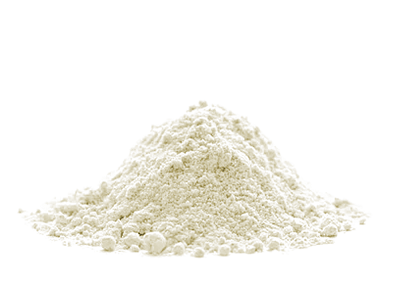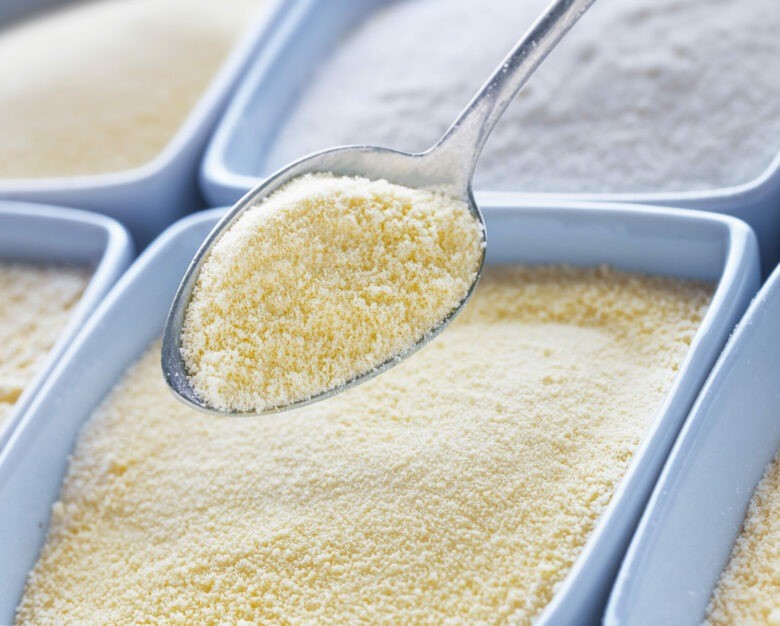Buttermilk Powder - Types, Processing & Usage
After pasteurization and concentration with an evaporator, the buttermilk is spray-dried to produce buttermilk powder (BMP). Typically, the product is light yellow in color and has a rich, creamy flavor.
 Spray-drying buttermilk, obtained by churning cream into butter, produces buttermilk granules. While buttermilk has a greater fat content, its composition is similar to skimmed milk. It contains a lot of phospholipids and milk fat globule membranes. Due to its unique composition and several useful features, buttermilk powder (BMP) is a desirable substance for various uses. Proteins in buttermilk powder can operate as emulsifiers, stabilizing oil-water interfaces in products such as sauces, dressings, or ice creams.
Spray-drying buttermilk, obtained by churning cream into butter, produces buttermilk granules. While buttermilk has a greater fat content, its composition is similar to skimmed milk. It contains a lot of phospholipids and milk fat globule membranes. Due to its unique composition and several useful features, buttermilk powder (BMP) is a desirable substance for various uses. Proteins in buttermilk powder can operate as emulsifiers, stabilizing oil-water interfaces in products such as sauces, dressings, or ice creams.
Processing of Dry Buttermilk Powder
Buttermilk powder is a dried milk product with a maximum water level of 4% and a fat content of 4–8%.
It is created using fresh, pasteurized, delicious buttermilk from a butter manufacturing facility (100 percent cow's milk) and gently dried by spraying.
The buttermilk powder contains at least 34% protein in fat-free dry matter. In addition, it has 3% fatty acids and around 48% milk sugar.
Recombination into fresh buttermilk: 90 g buttermilk powder and 910 g water generate 1 kilogram of buttermilk.
Draining the water from liquid buttermilk that is made by churning cream into butter and pasteurizing it before condensing, buttermilk powder, dry buttermilk, or dried buttermilk powder is produced.
It has 4% or more milk fat and 5% moisture by weight or less. It must have a protein concentration of no less than 30%. It may not contain, or be derived from, nonfat dry milk/skimmed milk powder, dry whey, or products other than buttermilk and has no additional preservatives, neutralizing agents, or other chemicals. Microbial development is stopped by eliminating as much moisture as feasible. There are two types of dried buttermilk powder: roller-dried and spray-dried. Also, Buttermilk powder can be produced from sweet cream buttermilk or acidified buttermilk but sweet cream buttermilk is preferred because it is more stable.

Buttermilk Powder Use
Sliced tomatoes with salt become a legitimate side dish for practically any dinner when they are seasoned with buttermilk powder.
Coat thinly-sliced cucumbers with buttermilk powder and add finely chopped chives for a salad that serves as a pickle-like topping for sandwiches.
For a dessert, you won't soon forget, coat peaches in brown sugar and buttermilk powder before grilling.
- Buttermilk recombination
- Skim milk powder substitution
- Partial whole milk powder substitution
- Dietary food
- Instant drinks
- Pastries and confectionery items
- Bread spreads,
- Margarine
- Chocolate products and confectionery
- Desserts, sweet dishes, yogurt
- Ice cream
- Custard powder
- Soups, sauces, ready meals

The Advantages of Buttermilk Powder
The following are some of the product advantages of buttermilk powder:
- Excellent solubility and processing characteristics
- Improved emulsifying properties in food
- Rich in proteins and minerals
- Improved aroma of ready-to-eat food
- Balances the taste of baked goods and stuffings
- Improved freshness of baked goods
- Improved browning of baked goods' crusts
- The protein source in food
- Pure natural product without additives = Clean Label ingredient
- Long shelf life
- Simple to store
Benefits of Buttermilk for Health
- Blood pressure, bone, and dental health can all be enhanced by buttermilk, among other health advantages.
- Possibly more easily absorbed than other dairy products
- Good for healthy bones
- Can enhance dental health
- Possibly beneficial for lowering cholesterol
- Related to reduced blood pressure
The Health Concerns About Buttermilk
Due to its high salt content and ability to trigger allergic responses in certain people, buttermilk may potentially have a number of negative health effects.
- Sodium levels may be elevated
- Some people may experience allergic reactions or stomach problems
Buttermilk should not be consumed by anybody who is allergic to milk, not only those who are lactose intolerant. Milk allergy can result in stomach distress, hives, wheezing, vomiting, and even anaphylaxis in some people.
Conclusion
After pasteurization and concentration with an evaporator, the buttermilk is spray-dried to produce buttermilk powder. Typically, the product is light yellow in color and has a rich, creamy flavor.
The buttermilk powder's high phospholipid content makes it valuable to food manufacturers and the dairy sector. Good emulsifying characteristics result from this. Buttermilk powder and skim milk powder have many of the same chemical constituents. Buttermilk has a little larger fat content (4–8%) than skim milk powder, but both have an equal amount of protein.
The flavor of a good buttermilk powder is very appealing. High amounts of phospholipids, excellent solubility, homogeneous fat content, and good emulsifying characteristics produce a rich, creamy flavor. Soon buttermilk powder will be included in Chaltafarm's products portfolio.
Read More: Navigating Global Dairy and Milk Powder Export Markets
To contact the Chaltafarm dairy export department, refer to the contact section.
| https://www.healthline.com/nutrition/buttermilk#what-it-is |
| https://numidiadairy.com/buttermilk-powder-bmp |
| #chaltafarm_buttermilkpowder #buttermilkpowderdbenefits #drybuttermilk #BMP |


-min.webp)
.webp)

.webp)